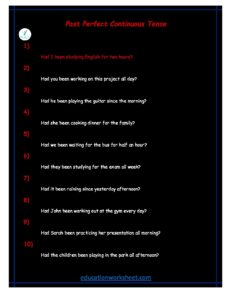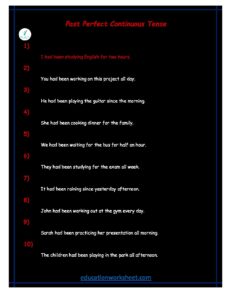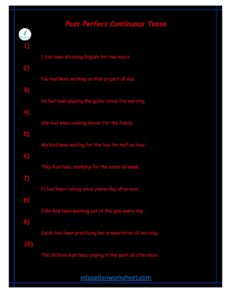how to converting Past Perfect Continuous Tense negative sentences to interrogative form
how to converting Past Perfect Continuous Tense negative sentences to interrogative form
Introduction
Understanding how to convert Past Perfect Continuous tense negative sentences to interrogative form is a crucial aspect of English grammar. In this comprehensive guide, we will explore the rules and techniques for transforming negative statements in the Past Perfect Continuous tense into interrogative sentences. By the end of this extensive explanation, you will have a firm grasp of this grammatical concept.
I. The Basics of Past Perfect Continuous Tense

Before delving into the conversion process, let’s first establish a solid foundation regarding the Past Perfect Continuous tense. This tense is used to describe actions or events that started in the past, continued for some time, and were still ongoing at a specific point in the past. It’s typically formed by using the auxiliary verb “had,” the past participle of “to have,” and the present participle of the main verb with “been.” For example: “She had been studying for two hours.”
II. Understanding Negative Sentences in the Past Perfect Continuous Tense
Negative sentences in the Past Perfect Continuous tense are formed by adding the word “not” after the auxiliary verb “had.” For instance, “She had not been studying for two hours” is a negative sentence in this tense. In negative sentences, “not” plays a crucial role in expressing the absence of an action or event. Knowing how to transform these negative sentences into interrogative sentences is an important skill for effective communication.
III. Converting Negative Sentences to Interrogative Form

To convert a negative sentence in the Past Perfect Continuous tense into an interrogative sentence, you need to follow these steps:
- Begin with the auxiliary verb: Start your interrogative sentence with the auxiliary verb “had.” This sets the tense and indicates that the question is about a past action or event that was ongoing.
- Add the subject: Place the subject of the sentence immediately after the auxiliary verb. The subject should be the same as in the original negative sentence. For example, if the negative sentence is “She had not been studying for two hours,” the subject is “She.”
- Follow with the auxiliary “been”: After the subject, include the auxiliary “been.” This reinforces the continuous aspect of the action. In our example, it would be “had she been.”
- Insert the main verb in the present participle form: The main verb should come next, in the form of the present participle (verb + “ing”). In our example, this would be “studying.”
- Include the time reference: Finally, add a time reference or question word, such as “how long” or “since when,” depending on the context of your question. In our example, we could ask, “How long had she been studying?”
By following these steps, you can effectively convert negative sentences in the Past Perfect Continuous tense into interrogative sentences. This process allows you to seek information or clarification about past actions or events.
IV. Examples and Practice
Let’s practice with some examples to solidify our understanding:
Original Negative Sentence: “They had not been working here for a year.”
Interrogative Form: “Had they been working here for a year?”
Original Negative Sentence: “He had not been playing the piano since morning.”
Interrogative Form: “How long had he been playing the piano since morning?”
Original Negative Sentence: “We had not been traveling all night.”
Interrogative Form: “Had we been traveling all night?”
how to converting Past Perfect Continuous Tense negative sentences to interrogative form

By practicing the conversion of negative sentences to interrogative sentences, you can become more proficient in using the Past Perfect Continuous tense in different contexts.
V. Additional Considerations
While the basic rules for converting negative sentences to interrogative form are straightforward, it’s essential to consider the context and tone of your questions. Depending on the situation, you may need to adjust your wording and intonation to convey your message effectively. Additionally, be mindful of the choice of question words, as they can significantly impact the meaning of your interrogative sentence. Practice is key to mastering this skill, so continue to work with examples and engage in conversations to refine your ability to convert Past Perfect Continuous tense negative sentences into interrogative sentences.

